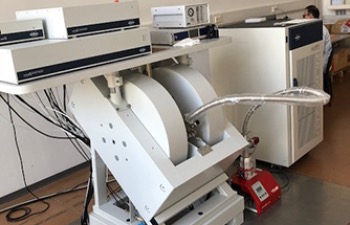View All Solution NMR at Instruct
View All Magnetic Resonance Techniques at Instruct
Electron Paramagnetic Resonance (EPR)-based methods have been used to map local dynamic and structural features of biomolecules, to explore different modes of biomolecule-ligand interaction, to obtain long-range structural restraints and to probe metal-ion-binding sites.
The Center of Magnetic Resonance (CERM) facility includes two EPR instruments (Continuous-wave X-Band and Continuous-wave/Pulse Q-Band), the necessary sample preparation wet lab (including glove-box) and the necessary processing computer. EPR measurements can be performed on biological samples containing paramagnetic metal ions (i.e. Fe, Cu, Mn etc.) or on samples opportunely labelled with paramagnetic tags (i.e. spin labels). The pulse Q-band EPR instrumentation present at CERM permit to measure DEER, HYSCORE and ESEEM experiments.
Spectrometer Q-Band CW/FT-EPR ELEXSYS E580 with the possibility of operating in CW-X-band.
All tubes and capillaries should be filled to the same volume. Sample heights are in addition to the hemi-spherical tube bottom. If there are issues with the amount of sample available, we may be able to work with smaller volumes. However, we suggest to use the preferred sample heights to fill completely the EPR cavities in order to have spectra with high signal-to-noise ratio.
Preferred:
EPR spectra can be recorded at different temperature, between 298K and 4K. For cryogenic conditions and pulsed Q-band measurements, samples must be previously frozen. Freezing is done by placing the bottom tip of the tube in liquid nitrogen until it starts to fizzle, then lower the tube into the liquid nitrogen at about 1mm/sec. This will allow for sample expansion upwards during freezing, thus preventing the tube from cracking. Rubber septa and commercial blue caps should be removed because they will admit liquid nitrogen, resulting in tube explosion and injury upon removal from storage. For aqueous samples, 30%-10% v/v glycerol or ~0.4 M sucrose can be used as a glassing agent.
The support offers sample preparation, instruments setup, data acquisition and data analysis. Based on the visiting scientist expertise assistance and supervision will be assigned.
Before their visit, the visiting scientist must communicate the scientific plan of the experiments and the contacts to arrange the visit. Visits to the facilities may range from one day to weeks, depending on the complexity of the work to be performed and the experience of the visiting scientist in the field.
For remote access, if the samples are not shipped in the quartz EPR tube, our staff takes care to transfer it from the vial to the tube; air-sensitive samples will be handled in an oxygen-free chamber. Our staff will operate following the protocol for operations (air/light sensitivity, temperature of storage, etc…) provided together with the samples.

